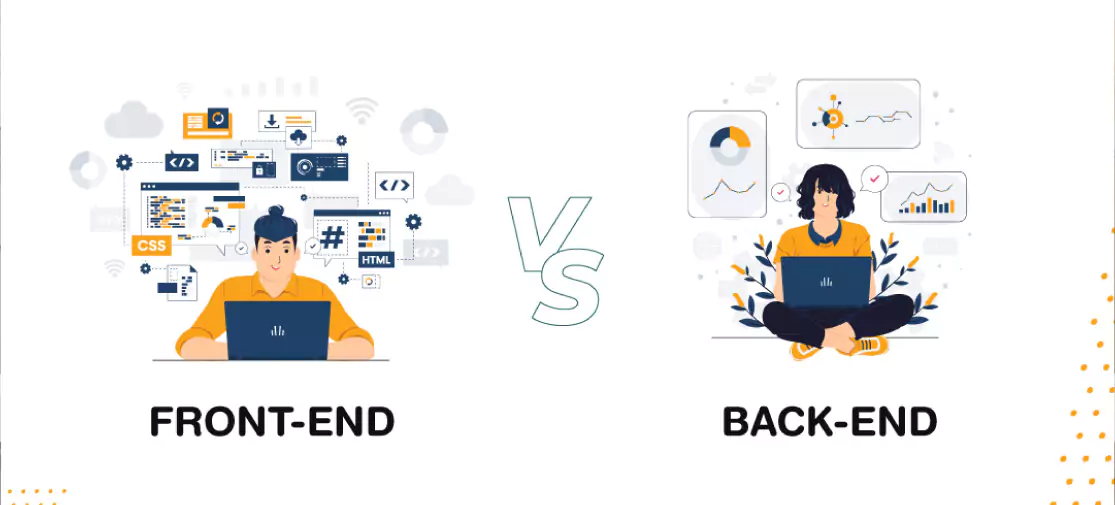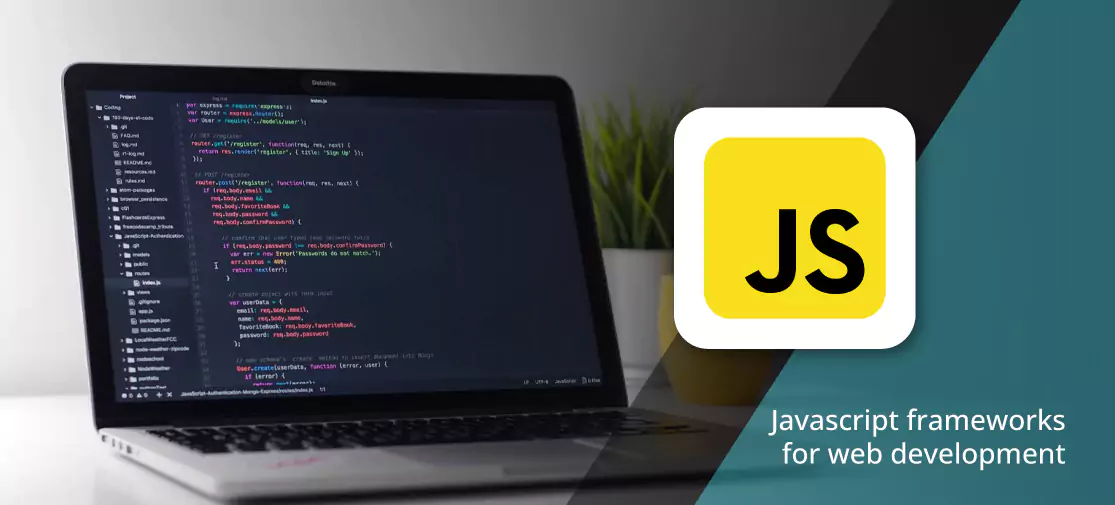Overview
Uncertain of the distinction between front-end and back-end development? Find out which might be your best option
The front end, which users see, and the back end, which is the supporting background code for the front end, are the two components that make up a website. It might be challenging to comprehend the distinctions between front-end and back-end development because of how similar they are in terms of making sure that websites operate efficiently.
Front-end developers design the fonts, colors, and styles that users interact with on websites. Back-end engineers provide the invisible infrastructure that enables websites to function properly. Given that they possess a unique set of technical skills, front-end developers make less money than back-end developers.
Full-stack developers handle every part of a website by using their knowledge of both front-end and back-end coding. Continue reading to find out more about the distinctions between front-end and back-end development, as well as the key competencies required for each.
What is front-end development
Front-end development places a strong emphasis on a website's user-experience. Front-end developers make sure consumers can easily interact with and navigate websites by using computer languages, design knowledge, and other technologies. They design the drop-down menus, layouts, and aesthetics for websites.
Websites are developed by front-end developers using HTML, CSS, JavaScript, and other computer programming languages. Every language has a certain purpose. HTML establishes the structure and content of the website, while CSS adds design elements and JavaScript creates advanced interactive features. Front-end developers that are fluent in Python, PHP, or Ruby are less common.
Front-end development focuses on the user-facing side of a website.
These programmers require proficiency with jQuery, Bootstrap, AngularJS, and EmberJS, among other frameworks and libraries. In contrast to libraries, which condense code into smaller, more time-efficient packages, frameworks guarantee that information displays appropriately on all devices. Along with code editing products like Notepad or Eclipse, front-end developers may also utilize graphic design software like Photoshop or illustrator.
To guarantee that websites' user interfaces appear good and work effectively, front-end development takes both technical know-how and creativity. User experience analysts, designers, and back-end developers collaborate with front-end developers.
A front-end developer frequently needs a bachelor's degree in web design, programming, computer science, or graphic design. Some people gain these skills through former employment, boot camps, or initiatives to find employment without a degree.
Below, we list the necessary abilities for front-end developers along with an explanation of their significance.
Front-end Developer Skill
- HTML: The general content and structure of a webpage are implemented using HTML, which is the industry standard.
- CSS: The colours, style, layout, and fonts of a web page are all created using CSS by front-end developers. To hasten the development process, these developers may employ CSS pre-processors like SASS or LESS.
- Javascript: For websites that include interactive elements like movies, audio, animations, and games, front-end developers use JavaScript. JavaScript comes with libraries that have plugins and extensions to make webpages operate more quickly.
- Communication skills: Front-end developers benefit from having strong communication skills when working on online projects with clients and back-end developers. It could be necessary for developers to explain design challenges to clients who aren't always tech-savvy.
- Creativity: Websites with inventive front-end developers have better visual appeal and usability. They contribute to a site's aesthetic appeal and usability beyond simple functioning.
What is back-end development?
Back-end developers concentrate on the website's server side. They employ their technical expertise to carry out the background tasks that produce a website's framework and general operation, enabling the existence of the site's front end. These experts design the functionality, databases, and application programming interface of a website (API).
An application, server, and database make up the back end. The components of back-end development that remain hidden beneath a website's surface are frequently not visible to computer users.
To create apps, back-end developers need comprehensive knowledge of server-side programming languages like Java, Python, and Ruby. By completing boot camps, students can gain knowledge of or brush up on particular computer programming languages. For instance, take a look at our article on the top Python boot camps.
Back-end developers specialize on the website's server side.
Tools like SQL Server and Oracle are used by back-end developers to store, manage, and modify data. Employers frequently need proficiency with version control software, PHP frameworks, and troubleshooting back-end systems and apps. To comprehend the objectives of each project, back-end developers work together with front-end developers, management, and business stakeholders.
Back-end developers are typically required to have bachelor's degrees in computer science, programming, or web development for their employment. Some back-end developers can get jobs by studying through relevant work experience or boot camps without obtaining four-year degrees.
Some back-end developers can convert their experience into higher-paying positions as software engineers with extra training, schooling, or certifications. The abilities that back-end developers often have are described below.
Back-end Developer Skill
- Python: Python programmers construct data structures and algorithms that are used to build websites. Additionally, they make use of Python frameworks and modules like Flask, Django, and NumPy.
- Java: On the back end, developers create apps using the Java programming language, which was developed for platform interoperability.
- Ruby: Ruby is a back-end programming language that is open-source and free. It allows back-end developers to swiftly develop new applications. Ruby comes with everything a website needs to function; therefore full-stack developers frequently utilize it as well. Ruby performs very well on busy websites.
- Skills for solving issue: To solve technical issues that arise during the establishment of a website, back-end development frequently calls for problem-solving abilities. Debugging and testing of back-end systems and apps may be among these jobs.
- Communications skill: Strong communication skills are essential for back-end developers to successfully execute projects. Web designers may need to communicate complex technical challenges to non-technical stakeholders.
Different launguages are used by front-end and back-end developers.
You'll utilize programming language when you're coding. These languages enable programmers to interact with their computers using a set of symbols, much like human languages (referred to as code). It is essentially the same as instructing your computer. HTML, CSS, and JavaScript are some of the languages used by front-end developers.
Hyper Text Markup Language is known as HTML. It serves as the industry standard markup language for websites.
- Cascading Style Sheets, or CSS, is an abbreviation. While CSS adds style and flair to a website, HTML is utilized to give it structure. It establishes the typefaces, colors, and other aesthetic features of a website.
- JavaScript is a language that may be utilized to create interactive and entertaining websites. For instance, you could use it to host a game on your website.
Additionally, the front end utilizes a unique collection of libraries and frameworks. A front-end developer might use the following frameworks and libraries, to name:
Langauges including PHP, C++, Java, Ruby, Python, JavaScript, and Node.js are used by back-end developers. For further information on a couple of these languages:
A server-side programming language is PHP.
Python is a general-purpose coding language, and Java is a platform and programming language that is very well-liked. It differs from some of the others we've listed here because it isn't just confined to web development and can be used for other types of software development as well.
The following back-end frameworks are available:
- Express
- Django
- Rails
- Laravel
- Spring
Front-end and back-end programmers may produce fantastic applications
While certain similarities between the two sides of web development, it's easier to think of them as the two sides of a cassette tape. They are both crucial steps in the process of creating functional, appealing websites and applications online.
Therefore, if you're considering a career in web development but aren't sure which side of the development cassette you're interested in jamming to, you might consider becoming a full-stack developer.
Developers who work across the full stack gain the most from using both front-end and back-end components in their projects. It's like having access to the entire cassette every day.
They are strong team members because they can see the broad picture and offer suggestions on how to improve the process or get rid of obstacles that might be slowing down the system.




